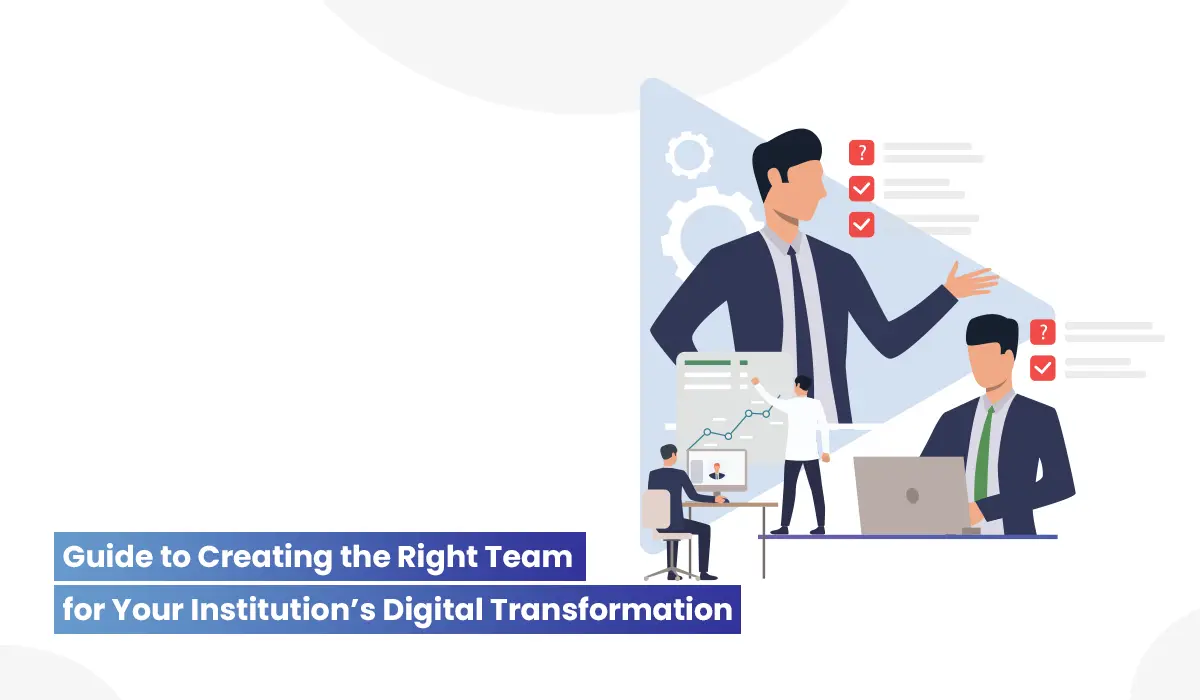The Role of a Project Committee in Digital Transformation
Why do some institutional digital transformations fail while others completely change whole institutions? The hook lies in one critical thing: the project committee. Institutional digital transformation is no longer just a choice for higher education; it’s now essential to the success of modern institutions.
Without the right team leading the way, even the best plans can fail. The chances of an institution reaching its digital goals are 2.5 times higher if its project groups are well organized, according to research! There’s a bigger picture here than just managing a project. Your committee is shaping the future of your institute.
Partially deciding who does what is not the only thing that matters. A strong group of thinkers, problem-solvers, and decision-makers can make goals come true. The question is, what makes a dream team, and how can your institution put together one? Now, let’s get into the nitty-gritty.
Why Institutional Digital Transformation Needs Project Committees?
Embracing new technology implementation in institutions is just one part of institutional digital transformation in higher education; the process also involves changing the culture and practices of institutions. Still, there will be problems along the way, like how hard it is to update systems, get people from different groups to work together, and get people to accept and gain from change.
In this case, the digital transformation project group must be well organized. Committees create goals and monitor progress to help change efforts succeed. Since they may adjust their plans, they can face issues head-on.
Maintaining a sense of responsibility is essential. If there is a digital transformation project committee, then everyone on the team will be responsible for their part of the change. Committees bring multiple viewpoints to address the full gamut of challenges: experience from information technology (IT), administration, faculty, and other departments. Together, they create the kind of innovative solutions that pave the way for positive digital transformation.
Key Members to Include in the Digital Transformation Project Committee
Digital transformation demands clear roles and responsibilities and more than a group. Clear project committee roles improve transformation efficiency. In it, everyone knows their roles, so responses are faster. Here are the essential roles of the higher education digital transformation project committee:
Assigning Roles and Responsibilities Within the Committee Members
Now that you have your essential players, make sure everyone knows their roles. The committee must have clear duties and responsibilities to work well and achieve its goals. Here are typical duties for each role:
Executive Sponsor
Executive Sponsors are your project’s top supporters. They acquire funding, top leadership support, and project alignment with the institution’s vision. Their role is to move the project forward and remove obstacles. Without them, the project may lack top-level direction and support.
A Project Manager
This individual manages the project daily. They organize, manage, and track deadlines. They oversee project timelines and budgets. Strong project managers pay attention to every detail and finish on time.
Subject Matter Masters
SMEs offer digital transformation competence (admissions, student services, tech). They suggest solutions that meet the institution’s needs and offer design and implementation help. SMEs connect tech solutions to institutional needs.
IT Leads
The IT Lead ensures smooth technical operations. They integrate new technology, maintain security and compliance, and resolve technical concerns. They must oversee infrastructure and data security.
Swap Champions
These people manage grassroots transformation. They handle resistance, promote adoption, and motivate staff and faculty. Unless people are onboarded and trained, even the best technology can fail without Change Champions.
A Faculty Rep
Faculty represent teachers’ needs and viewpoints. They ensure institutional digital transformation doesn’t disrupt learning and faculty demands are considered. Faculty input is crucial to campus development and developing a system that works for everyone.
Students’ Representative
Improved student experiences depend on their voices. This individual ensures improvements satisfy student learning, communication, and accessibility needs. Many of the systems being altered are used by students, so their feedback is vital.
Finance Officer
The Financial Officer manages the budget. They manage spending, finance, and project budget. They ensure project budget and resource efficiency.
Law and Compliance Advisor
This person ensures the project respects all laws, policies, and regulations, notably data privacy and security. Avoiding legal issues requires a dedicated person.
External consultant if needed
If needed, external experts provide project expertise. They can offer best practices and cover team knowledge gaps. A third party may provide fresh perspectives to help the team avoid surprises.
Steps to Define the Purpose and Objectives of the Committee
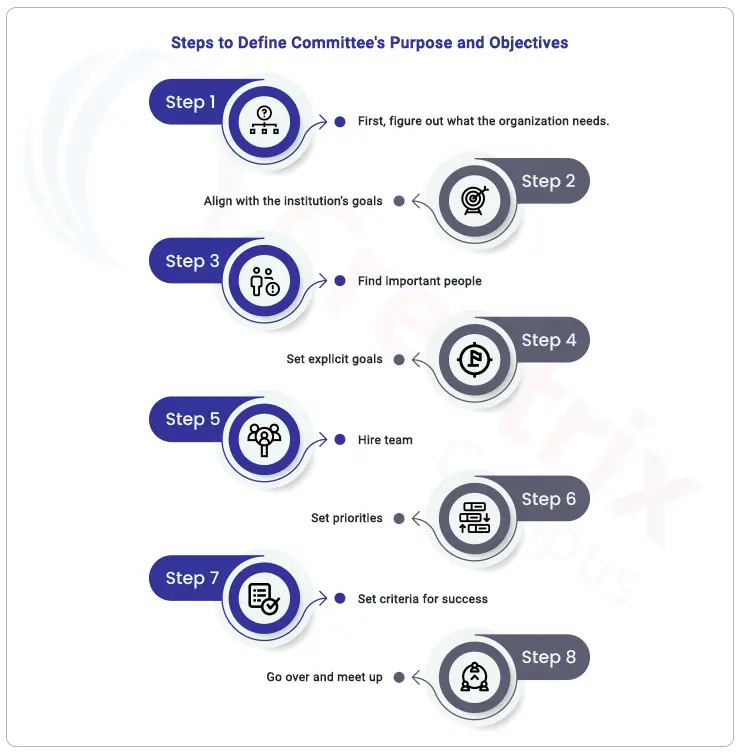
Step 1: First, figure out what the organization needs.
Look at the goals and problems of your organization. Find the places where going digital can make the biggest difference.
Step 2: Align with the institution’s goals
Make sure that the committee’s goals are in line with the institution’s long-term mission and plan. This will help the transformation program support the institution’s goals.
Step 3: Find important people
Find out who will benefit or be affected by the move to digital, such as students, staff, teachers, and administration. This group’s needs should guide the group’s goals.
Step 4: Make your goals clear
SMART goals should be used to make changes, like running the business or making the school experience better for students.
Step 5: Put together a group
Write down what each person in the group does to help the group reach its goal. This covers everything that’s important and makes sure that everyone is responsible.
Step 6: Write down your goals
Put your goals in order of how important they are and how doable they are. Think about what makes things useful now and in the future.
Step 7: Set goals to reach them
Things can be judged by how involved the students are, how well the business runs, how much money it has, how many people accept it, or how it’s planned.
Step 8: Get together
As new information comes in, the committee’s goals should be changed to meet the needs of higher education.
Strategic Contributions of a Project Committee
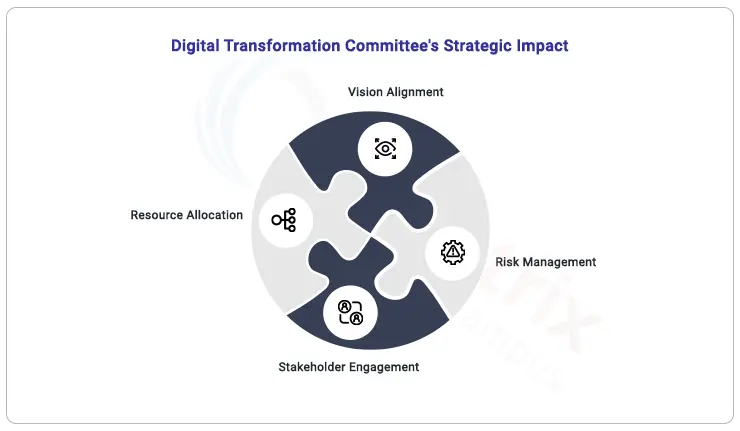
Institutional digital transformation project committees supervise daily operations and strategize long-term success in this way:
Vision Alignment
The committee makes sure the digital transformation project fits the institution’s aim. By understanding institutional priorities, the committee steers the initiative in the appropriate direction and ensures it contributes to the institution’s vision.
Risk Management
Financial, operational, and reputational risks come with digital transformation. Early risk identification and mitigation by a strong committee reduces setbacks. The committee can foresee and mitigate project issues with different skills.
Stakeholder Engagement
Leadership, faculty, staff, and students must communicate well to succeed. Communication is key, and the project committee ensures everyone is informed and engaged. The committee ensures buy-in from all groups by addressing issues and receiving feedback, smoothing the transition.
Resource Allocation
The committee prioritizes resources! The committee carefully manages funding, staffing, and technical investments to maximize ROI. Allocation ensures the organization benefits from transformation by implementing the best options.
Setting Up the Campus Digitalization Governance Structure
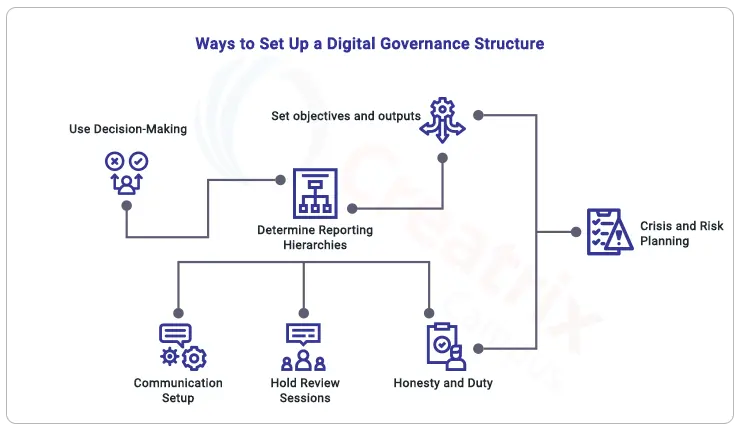
Digitization needs a good governance structure! It ensures order and transparent decision-making. Setup:
Use Decision-Making
Regulate committee decision-making. Most votes, consensus, or executive sponsor approval? Avoiding misunderstanding and delays with a clear decision-making process helps the committee act quickly.
Determine Reporting Hierarchies
Who reports to whom? Early clarification ensures everyone knows their direct channel of communication. The project manager may report to the executive sponsor, while committee members may report to IT or faculty leaders. The organization is maintained by hierarchy.
Set Objectives
Determine project milestones and outputs. These project milestones will be monitored. Goals-based timelines keep everyone focused.
Crisis and Risk Planning
Campus digitalization governance involves risk management and decision-making. Risk planning is necessary for risk management. After an unforeseen event, the committee can quickly adjust and minimize disruption.
Honesty and Duty
Establish transparency and accountability. Progress reporting, decision documentation, and stakeholder communication are required. Unanimity eliminates misunderstandings and missing chances.
Hold Review Sessions
Discuss achievements, challenges, and plan modifications with the committee periodically. The meetings coordinate and allow course modifications.
Communication Setup
Communicate clearly using email, project management software, or meetings. Communicating with the committee is crucial.
Challenges in Forming and Managing a Digital Transformation Committee
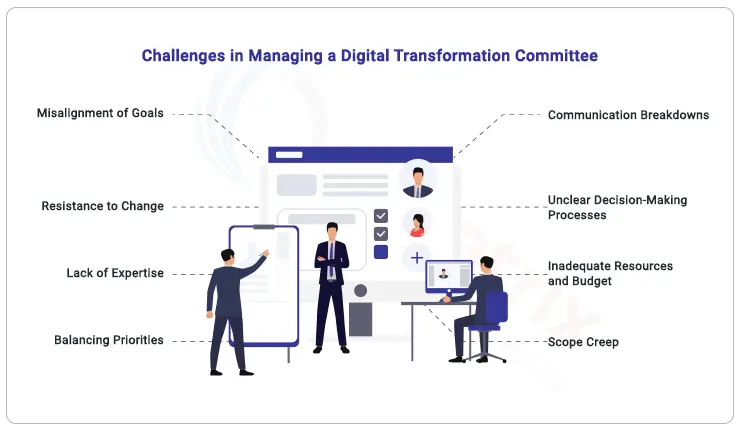
Forming and leading a digital transformation committee is exciting but difficult. These obstacles can make it hard to guide the committee toward the institution’s aims. Examples of frequent challenges and ways to overcome them:
Misaligned Goals
One of the major problems is aligning all committee members with digital transformation goals. Committee members may have diverse opinions based on their duties, and without a clear goal, it might be simple to stray. Smooth functioning requires everyone to understand and support the same goals from the start.
Change Resistance
Change management in education is common in digital transformation. With new technologies and processes, faculty, staff, and stakeholders may feel intimidated or uncomfortable. Resolving this opposition requires clear communication, stakeholder engagement, and committee change champions who can promote the shift.
Poor Expertise
While a project committee can bring together stakeholders, technical or digital tool skills may be lacking. Without the right SMEs, the committee may struggle to make judgments. Include members who understand the institution’s needs and the technologies involved to address this.
Balanced Goals
Numerous committee members balance different tasks and priorities. Other roles may tug committee members in different ways, causing time and attention issues. The committee must prioritize its work and give members appropriate time for the assignment.
Trouble Communicating
Diverse teams can have communication issues if duties aren’t clear or updates aren’t communicated. To keep everyone in sync and provide information quickly, effective communication is essential. Without effective communication, the committee may miss opportunities or delay matters.
Uncertain Decisions
Decision-making confusion can cause delays and frustration. Members may disagree or be unsure of how to proceed without a clear decision-making framework. Avoid decision deadlock by setting clear guidelines for decision-making and who has the final say.
Insufficient Budget and Resources
Technological, training, and support investments are common in digital transformation projects. The committee might stall development if it lacks resources and funds. Leadership support and early funding are crucial to the committee’s success.
Scope Creep
It’s tempting to add features or adjust the scope as projects progress. Scope creep can cause delays, higher costs, and less concentration. Keep the group focused on the agreed-upon goals and plan and approve any amendments to avoid scope creep.
Overcoming Challenges in Managing a Digital Transformation Committee
A digital transformation committee can be difficult to organize and manage, but there are simple solutions. Let’s simplify:
Communicate clearly. Be clear about expectations from the start. Establish roles, goals, and duties and communicate regularly. It aligns everyone.
Digital transformation requires teamwork. Encourage open dialogue and collaboration. Higher input is preferable. This guarantees everyone is heard.
Be flexible. Digital transformation changes quickly. Adjust your plans and strategies as needed. Monitor progress and adjust. Flexibility maintains momentum.
Keep learning. Not everyone is an expert straight immediately. Give your crew training and resources to stay organized. Knowledge is power and simplifies decision-making.
You may need outside help. Use transformation-experienced experts. They can identify issues early and suggest novel solutions.
Grab smart tools. Track progress and goals with strategic planning tools. It streamlines tasks, deadlines, and KPI management. If plans go awry, you can change them.
Monitoring the Success of the Committee
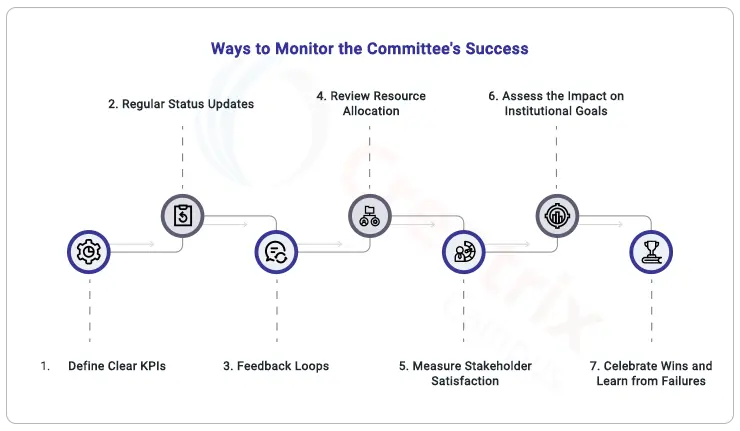
After launching, your digital transformation committee must track its goals and progress. Track the committee’s progress to improve and stay on track. Monitor committee performance:
Establish KPIs: Define success to track it. Scheduled milestones, budgets, and stakeholder participation are examples. Set KPIs to track progress and ensure the committee meets digital transformation goals.
Status updates regularly: Communication matters. Monitor committee progress with regular updates. Meet to review progress, handle obstacles, and keep the project on track. You can notice issues before they escalate using updates.
Reverberations: Important to gather committee and stakeholder input. Feedback reveals issues and growth opportunities. Be transparent and use feedback to improve processes and results.
Examine Resource Distribution: Track budget, time, and personnel to see if the committee is staying under budget. If resources are abused or underused, project changes may be needed.
Monitor Stakeholder Satisfaction: Faculty, staff, and students must be satisfied for the digital shift to succeed. Poll these groups often to measure how well the transformation is accepted and how well the committee is addressing their concerns. Dissatisfaction should encourage the committee to improve results.
Institutional Goal Impact: Assess your institution’s digital transformation project’s success. Does it improve education? Do administrative processes work better? Improves student engagement? The committee prioritizes what matters by aligning progress with institutional goals.
Enjoy successes, learn from losses: Recognize small achievements. Celebrate wins to foster teamwork. Analyze setbacks and improve future efforts. Successful and unsuccessful people learn and evolve.
Conclusion: The Path Forward
As digital transformation reshapes higher education, a strong project committee becomes more essential. These committees serve as the backbone of successful initiatives by offering governance, guidance, and collaboration to navigate challenges and meet institutional goals.
Strategic planning and a clear structure lay the foundation for success. By assembling the right team, assigning clear responsibilities, and monitoring progress, institutions can drive meaningful change, improving operations, and student experiences, and fostering innovation.
For institutions to thrive during this transition, the right tools and systems are key. By focusing on the right approach, higher education can effectively embrace transformation and build a brighter future for both staff and students.
Let’s improve higher education together. Get in touch with the right committee for higher education technology projects! Connect with Team Creatrix Campus.







